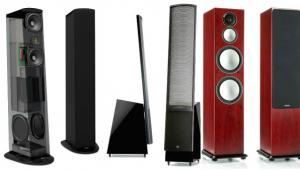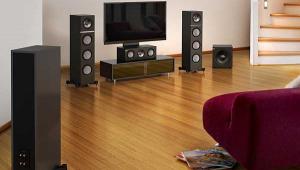The Art of Listening: Your Guide to Evaluating Speakers

Setup
The listening room is at least as influential on the sound you hear as the speakers themselves, so shoot for optimal placements. (If in doubt for a particular model, consult the manufacturer’s recommendations.) Choose an amplifier or receiver that’s as powerful (within reason) and as excellent as you can afford; at rational listening levels, “too much” available power will never compromise a speaker’s sound, but too little power definitely can. Beyond that, qualitative differences, if any, among amplifiers will be utterly swamped by the tiniest of speaker differences, so forget about ’em. Ditto cables, power conditioners, antiresonance juju, and even different CD players or streaming sources.
Source Quality
High-resolution audio is by no means required. However, you should avoid lower-bit-rate MP3s and the like. And you should know that hi-res and “audiophile” recordings—whether digital file, CD, or LP—are more likely (though hardly certain) to feature production values that are more lifelike and utilize a wider dynamic range. Either way, audition a speaker using the type of music you actually listen to; a speaker that sounds great on a woodwind quintet means little if you’ve no idea what an unamplified bassoon, French horn, or oboe really sounds like.
Levels
Listen at levels similar to those you use at home, or if you do go a bit louder, don’t go crazy. Listen to naturally captured, acoustically derived music (classical, acoustic jazz, folk); you can’t judge a synth or a vocodered/Auto-Tuned vocal for realism if there’s no real there. Listen at something approaching lifelike levels, though if you’re a heavy rocker, adjust accordingly—but don’t try to evaluate home speakers at truly rock-concert levels. Your ears don’t work as well there, nor will most speakers show their best.
A/B It…or Not
An A/B environment, allowing you to switch more or less directly between two speaker models, is one gold standard. The second-zone stereo outputs on most receivers make this relatively easy to accomplish. It’s a psychoacoustic fact that one speaker playing even barely louder than another—a virtual certainty between any two uncompensated models—will be perceived as “better.” Consequently, you must ensure that the competitors will play at essentially equal loudness (within 1 decibel or better) at an accepted midband reference frequency range, such as a 400-hertz narrow-band filtered noise. (A/V receiver calibration “match” noise can serve this purpose if nothing better is available.) This requires an accurate SPL meter; the free SPL Meter iOS/Android app from Studio Six Digital is a modern replacement for the (formerly) ubiquitous RadioShack handheld, and it works fine. And since room placement is so influential, it’s an excellent idea to reverse the physical locations of the two speaker pairs regularly, even when they’re literally side by side (which they should be). All of the above notwithstanding, don’t rely exclusively on A/B auditions. Include some extended, one-pair-at-a-time sessions, at a variety of levels and with a variety of music selections spanning your favorite genres. This way, you can get to know each speaker’s qualities and quirks.
Demo Material
Swallow your pride and choose demos not for their musical excellence or sophistication, but for their standard of recording neutrality and ability to highlight particular sonic aspects. You’ll probably develop a rotation of familiar tracks that can cover the bases efficiently, giving you a “wet read” of the most important sonic characteristics.
An important fringe benefit of this method is that you quickly become so thoroughly sick of these snippets that you cease to hear them as involving music, freeing you to listen into the playback for evaluative qualities. (Personally, I find it impossible to focus my full critical faculties upon both the music and the loudspeakers simultaneously— the music wins every time.)
And when all is said and done, just what, precisely, are you listening for? Ask that question of a dozen experts, and you’ll get a gross of answers, so take a tablespoon of salt before weighing any such advice, mine included. Nevertheless, here’s my checklist.
1) Tonal Uniformity
This means evenness of emphasis and trueness of timbre (tone color) over the broad range from bass to treble—by far the most important factor to my ears. It’s difficult or impossible to judge this as a whole, so I tend to break it into four subcategories:
• Vocal-range smoothness. Here I’m listening almost exclusively to voices, sung and spoken, for freedom from midrange response anomalies, the commonest class of weaknesses. Manifest in tone-color shifts I can pick out over a variety of different voices, these may induce a honky or nasal quality, a cupped tone (sounding as
if sung or spoken through cupped hands), or a persistent rasp or hollowness in timbre. (There are lots of other popular adjectives for vocal-range warts: hooty, shouty, pinched, tinny, and so on.) I count these among the most egregious of flaws, because when you’ve detected one, you begin to hear it coloring vocal tones as disparate as, say, Norah Jones and James Taylor, or James Earl Jones and Anderson Cooper. And then you notice it almost constantly.
• Bass/midbass anomalies. These are usually simpler to detect. They involve boominess or thinness, or a tendency to accentuate or shortchange discrete pitches, on instruments such as bass guitar, standup bass, and synth-bass. You have to know your recordings via numerous auditions on a variety of speakers (and headphones) to build confidence in blaming the speakers rather than the recordings. Additional midbass telltales are low male vocals that are chesty or overbearing, or anemic- or distant-sounding.
• Low-treble smoothness. Massed strings are my usual go-to here: I listen for an unnaturally edgy or dry string tone, or an overly syrupy one. This is one of the toughest calls, unless you have some experience listening to unamplified professional string sections. Even the best live strings can sound a touch harsh or steely sometimes, depending on group intonation, acoustics, and playing style. Instead, keep an ear out for the undesirable characteristics of a consistently strident, metallic, or aggressive tone, as well as unnaturally mellow or rich ones. Employ multiple recordings, since these qualities can be baked right into a given recording, too.
• Tip-top treble. In a great deal of music, very little actually happens above 13 kilohertz or so—and much of what does occur there we hear more as sparkle or air than as actual content. Jazz and rock cymbals are one reasonably easy-to-find high-treble hook. Hi-hat rides (the tick-tick-cha-tick-ticks that rhythmically glue together so much jazz and rock), from naturally recorded discs, make excellent test fodder. They contain clean transients that conveniently occur over and over and over again, pretty much unchanged, for a whole verse. Focus on the character of each individual tick, listening for signs of dullness or distance (too little overall top-octave), spittiness (too much or too uneven), and smearing, a sort of vague, lisping, un-metallic quality that real-life cymbals don’t have.
2) Bass Extension
It’s a rare speaker that can reproduce the full audio range, unrestricted, down to or below 25 Hz. Paradoxically, it’s equally rare to find one of at least lunchbox size that doesn’t produce useful musical output from 80 Hz on up. So when we talk about extension, we’re really talking about just two octaves—and one of them, the 20-to-40-Hz octave, sees very little action among traditional pitched acoustical musical instruments. (Big percussion, pipe organs, synthesizers, and movie-soundtrack booms and rumbles are another story.)
It’s relatively difficult to find natural recordings with real energy in the sub-40-Hz octave. Your best bets: big bass drum, late-Romantic classical music, and pipe organ. Of course, ultra-low synth-bass from hip-hop, EDM, and dubstep is commonplace, usually featuring a conveniently ever-present, sub-40-Hz synth-bass/drum line. But since this is usually just one or two notes, it’s unlikely to tell you everything you want to know. And thanks to the variability of room acoustics, it’s hard to judge real-world deep bass fully until you get the speakers home.
3) Spatial Character
This means imaging, soundstage, spaciousness, depth, and the hundred-and-one other nebulous adjectives we deploy to attempt to describe how well or poorly a pair of electromechanical devices conjures up the three-dimensional effect of music sounding in an actual acoustic space. This is among the most variable of loudspeaker characteristics, and it’s for sure the one that’s most difficult to compare with real life—because dimensionally, anyway, even at its very best, hi-fi does not in fact sound all that much like the real thing.
That said, I listen first for stability of the stereo image: Does the virtual location of the vocalist or soloist wander a bit from side to side or from front to back as he moves up and down through the scale? Is the soundstage arrayed between the center line of the two speakers, spread out even wider, or bunched up toward the middle? Is there a natural sense of front-to-back depth to instruments and voices, without an exaggerated (or repressed) degree of reverberation?
Every speaker distorts reality one way or another, so there are no absolute answers here. And different types of speakers will have inherently different imaging characteristics. Bipole systems, or dipole radiators such as most flat-panel drivers, will usually create an enhanced sense of depth and space, at some sacrifice in imaging precision and tightly localized instrumental soundstage. Controlled-directivity designs like horns and certain multiple-driver arrays will tend to be just the opposite. The majority of conventional cone-and-dome two- and three-way systems will fall somewhere in between.
4) Dynamic Linearity
Virtually all speakers compress dynamics to some small degree. That is, beyond some level of incoming amplifier signal (at some frequency or frequencies), the speaker won’t keep producing clean in-room loudness equally over the full frequency range. One form of dynamic limiting is obvious from its audible distortions: A woofer or midrange (or tweeter) produces rude noises (thwacks, buzzes, snaps, pops, and so on) on high-level transients or signals. Another, far subtler form is non-linear response: Above a given (usually very loud) level, some portions of the audible range will continue to be able to get louder as demanded by the input signal, but others will not keep up. The result may be heard as a progressive brightening of balance at very high levels—in cases where the midrange/treble drivers can deliver greater ultimate clean level than the woofer section—or as a loss of weight and impact on strong, wide-band transients. The opposite may happen to systems where heating of the tweeters’ motor causes compression in that range, and loud passages can become dull-sounding relative to quieter ones.
The factors in my checklist above are all notoriously hard to judge in casual listening sessions. Can you be sure you’re hearing speaker limits and not amp limiting or clipping? Speaker distortion and not room buzzes or rattles (or, again, amp clipping)? A telltale high-level brightening from speaker dynamic limits and not the natural, acoustical, in-ear/brain distortion that occurs at very high SPLs? Unless you’re listening in a familiar environment, dealing with known acoustics and high-confidence amplification, you probably can’t be sure of any of those things.
Despite all that, I do listen to a favorite demo or two with highly dynamic percussion, for a sense of ease, weight (unfettered deep-bass elements), and lifelike snappiness free of the high-volume hardness that suggests increasing top-octaves distortion. But I temper my reactions and try hard not to leap to any conclusions without cross-checking in my own studio.
In the end, the answer to “How do you learn to evaluate loudspeakers?” is the same as the age-old one to “How do you get to Carnegie Hall?”: Practice, practice, practice. Many hours of critically listening to and comparing many different loudspeakers will make you vastly more adept at hearing differences, and at judging those you consider to be flaws or virtues.
















































